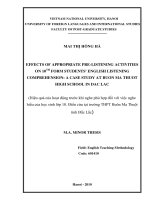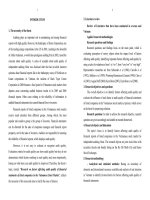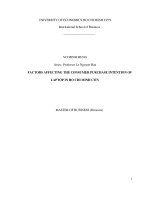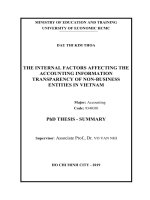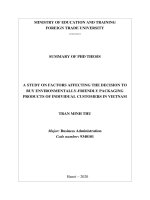Research on factors affecting the student’s satisfaction: a case study at the Da Nang University of economics, in Vietnam.
Bạn đang xem bản rút gọn của tài liệu. Xem và tải ngay bản đầy đủ của tài liệu tại đây (186.25 KB, 24 trang )
Research on factors affecting the student’s
satisfaction: a case study at the Da Nang University
of economics, in Vietnam.
Student : Duong Thi Thu Dieu
Class : SD-MBA1
ID : 11752303
Advisor : Dr. Chiang- Yuan Huang
Co-Advisor: Nguyen Hiep
OUTLINE OF PRESENTATION
1.
Introduction
q
Research Background/Motive
q
Research Purposes/Objective
2. Literature reviews
3. Research Methods
4. Concluding Remarks
o
References
INTRODUCTION
In the progress of development and integration, education is one of the most important
factors to develop country’s human resources. In order to upgrade quality of education
as well as to meet the expectation of training needs, education becomes more and
more socializing. In that process, under-graduated education plays an important role to
develop high-class human resources.
Nowadays, in a competitive marketplace where businesses compete for customers,
customer satisfaction is considered as a key differentiator and increasingly has become a
key element of business strategy. Thus, all corporations have tried to improve their ability
to meet potential and target customer expectation as well as make them satisfied. In
order to explore key factors that affect customer satisfaction, real surveys are necessary.
There is no doubt that real surveys are one of the most efficient ways to have proper
information and accurate data. This is mainly because they are designed to target
customers and processes. Surveying program is widely used in different fields. Most
of worldwide universities use this method to determine student satisfaction on their
services. Then, basing on the surveying results, proper action plants are taken to
improve current educational service quality. Another beneficial aspect of this method is to
enhance their brand name through this activity.
Keywords: Service quality, SEVRQUAL , Student’s satisfaction, Higher education, DUE
INTRODUCTION
Universities are considered as service providers. Their target customers and
services are completely specific comparing to other normal business. Due
to their differences, customer satisfaction is a key factor for surviving and
developing. Indeed, hearing customer voice and pay enough attention to
their demands and expectations are one of decisive principles of measuring
customer satisfaction. In educational field, quality of services have to be
measured basing on feedback and evaluation form students instead of specific
criteria or theoretical standards.
In all, Universities should objectively recognize and self-evaluate their current
service quality basing on customer needs and expectations. Also, efficient and
strategic solutions should be built on practical research. The study “Research
on factors affecting the student’s satisfaction: a case study at the Da Nang
University of economics” is carried out and formed basing on argument above.
RESEARCH BACKGROUND
Ø
Nowadays, tertiary educators are being called to account
for the quality of education that they provide.
Ø
In higher education, the definition of customer is quite different
from the manufacturing or general services since groups such
as students, employers, academic staff, government and families
are all customers of the education system with a diversity of
requirements.
RESEARCH BACKGROUND
§
Alridge and Rowley (2001) in particular suggested that the perceived service
quality of students is an antecedent to student satisfaction.
§
Hoffman and Bateson (1997) defined SERVQUAL as an attitude that is
established by a long-term assessment on overall performance. Service
quality is about delivery of excellent or high rate of service relative to
customer or exceeds their expectations (Tahar, 2008)
§
Parasuraman et al., (1985) defined service quality as a form of attitude that
is related to customers‟ expectations and perceptions.
§
According to Lassar, Manolis and Winsor (2000), two most prevalent and
widely accepted perspectives on service quality include the SERVQUAL
model and the Technical/Functional Quality framework.
RESEARCH BACKGROUND
§
Parasuraman, Zeithaml and Berry (1985) however listed ten
determinants of service quality that can be generalized to any type
of service:
- The ten dimensions include tangibility, reliability, responsiveness,
competence, access, courtesy, communication, credibility, security
and understanding.
- In addition, these ten dimensions were then regrouped in the well-
known five dimensions in the SERVQUAL model (Parasuraman et al.,
1990) which include assurance, empathy, reliability, responsiveness
and tangibility.
RESEARCH PURPOSE
v
The overall objective of the research is to recognize the underlying
factors of service quality of Danang university of economics (DUE).
q
To examine the relationship between service quality dimensions
(tangibility, responsiveness, reliability, assurance, empathy and overall
service quality) and students satisfaction
q
To examine critical factors in service quality (tangibility,responsiveness,
reliability, assurance and empathy) that contributes most to
satisfaction.
q
To propose a wide range of petitions and solutions to improve current
procedure and process as well as to make learners more satisfied.
LITERATURE REVIEWS
q
This section reviews the relevant literature on satisfaction and service quality,
service quality dimensions, and relationship among them.
q
Service quality
§
Service quality is a crucial concept in the contemporary marketing.
§
Service quality in the field of higher education can be defined as the difference
between student expectation and perception against actual their actual
experience.
§
Alridge and Rowley (2001) in particular suggested that the perceived service
quality of students is an antecedent to student satisfaction. Hoffman and
Bateson (1997) defined SERVQUAL as an attitude that is established by a long-
term assessment on overall performance.
§
Service quality is about delivery of excellent or high rate of service relative to
customer or exceeds their expectations (Tahar, 2008).
§
Parasuraman et al., (1985) defined service quality as a form of attitude that is
related to customers‟ expectations and perceptions.
LITERATURE REVIEWS
§
According to Lassar, Manolis and Winsor (2000), two most prevalent and widely
accepted perspectives on service quality include the SERVQUAL model and the
Technical/Functional Quality framework.
§
Gronroos (1984) held that service quality is made up of three dimensions "the
technical quality of the outcome", "the functional quality of the encounter" and
“the company corporate image”. He argued that in examining the determinants
of quality, it is necessary to differentiate between quality associated with the
process of service delivery and quality associated with the outcome of service,
judged by the consumer after the service is performed.
§
Parasuraman, Zeithaml and Berry (1985) however listed ten determinants
of service quality that can be generalized to any type of service. The ten
dimensions include tangibility, reliability, responsiveness, competence, access,
courtesy, communication, credibility, security and understanding. In addition,
these ten dimensions were then regrouped in the well-known five dimensions
in the SERVQUAL model (Parasuraman et al., 1990) which include assurance,
empathy, reliability, responsiveness and tangibility.
LITERATURE REVIEWS
q
Service Quality Dimensions
v
Parasuraman, et al., (1985) found 10 dimensions of service quality, that
include - tangibles, reliability, courtesy, responsiveness, security, competency,
access, communication, credibility, and understanding. Later in 1988, they
summarized these ten dimensions to five; tangibles, assurance, reliability,
responsiveness, and empathy:
•
Tangibles refer to the appearance of physical factors such as equipment,
facilities used by a service based company as well as to the appearance of
service employees.
•
Empathy refers to caring and individualized attention that the firm provides to
its customers
•
Assurance includes competence, courtesy, credibility and security. This
dimension involves capabilities such as delivering services with respect, polite,
and effective communication
•
Reliability can be defined as the ability to perform the service in an accurate
and dependable manner.
•
The responsiveness Dimension relates to the willingness of the company to
assist its customers in providing them with a good, quality and fast service.
LITERATURE REVIEWS
§
Student Satisfaction
•
Satisfaction is a function of relative level of expectations and perceives
performance.
•
Most student satisfaction study focus on the perspective of customer,
researchers is facing a problem of creating a standard definition for student
satisfaction thus providing a need of customer satisfaction theory to be selected
and modified so that it can explain the meaning of student satisfaction (Hom,
2002).
•
According to Sapri et al., (2009) mentioned that students’ satisfaction is a short-
term attitude that results from evaluation of their experience on education
services that they had received.
•
Kotler and Clarke (1987) define satisfaction as a state felt by a person who has
experience performance or an outcome that fulfill his or her expectation.
§
Many researches on students satisfaction that concerned with quality of courses
and teaching (Mavondo, & Zaman, 2000, & Sapri, et al, 2009).
LITERATURE REVIEWS
§
Service Quality and Students Satisfaction
•
Service quality and customer satisfaction are basically two different issues but
can be highly interrelated.
•
According to Gao & Wei,2004,the key to sustainable competitive advantage lays
in delivering high quality of service that in turn result to customer.
•
Satisfaction is a function of relative level of expectations and perceives
performance. The expectation may go as far as before the students even enter
the higher education, suggesting that it is important to the researchers to
determine first what the students expect before entering the university (Palacio,
Meneses & Perez, 2002).
•
According to the study by Kanji, Abdul Malek and Wallace (1999) do give
some insights on the real situation of the Higher Education Institutions in
Malaysia. Most institutions do give a great deal of importance to meeting
customers' expectations which is similar to business organization, but they
still lack customer awareness among the staff, and it has become a common
drawback for many institutions.
LITERATURE REVIEWS
Authors Scale Dimension
Bez- jian and Griego, 2006 Modified SERVQUAL Tangibility
Program content class structure
Responsiveness Assurance
Empathy
Bradley R. Barnes, 2007 Modified SERVQUAL Tangibles Reliability
Responsiveness
Assurance
Empathy
University
Guidance
Robert J. Angell, Troy W. Heffernan
and Phil Megicks, 2008
IPA Academic
Leisure
Industry links
Cost
LITERATURE REVIEWS
Authors Scale Dimension
John B. Ford, Mathew Joseph, Beatriz
Joseph, 2009
Modified IPA Academic reputation Career
opportunities Programme issues
Cost/time
Physical aspects
Location
Other
(Babar Zaheer Butt and Kashif ur
Rehman,2010)
§
Teachers’ expertise
§
Courses offered
§
Learning environment and
§
Classroom facilities
Aldemir and Gulcan (2004) Institutional factors
Extracurricular activities
Demographic
RESEARCH METHODS
Objectives of research
Information needs collection
Quantitative research
Collective Data
Process Data & Analysis information
Research Result
Observations
Sample Selection
§
Theoretical framework:
RESEARCH METHODS
q
This study will be adopted from Parasuraman’s SERVQUAL dimensions.
§
The dependent variable in this study is overall student satisfaction
§
The independent variable in this study is service quality at Danang
University of economics that measures the level of satisfaction with service
performance.
§
The dimensions included in this variable are tangibility, assurance,
responsiveness, reliability, and empathy.
•
Tangibles: physical facilities, equipment and appearance of personnel
•
Reliability: ability to perform the promised service dependably and accurately
•
Responsiveness: willingness to help customers and provide prompt service
•
Assurance.: knowledge and courtesy of employees and their ability to inspire
trust and confidence
•
Empathy: caring individualized attention the firm provides its
customers.
Ø
which can affect the student satisfaction with the quality of education offered
by Danang university of economics
RESEARCH METHODS
Tangibles Reliability
Career Guidance
Reasearch model: The conceptual framework of student satisfaction with
different educational services is presented here
Tangibles
Responsiveness
Assurance.
Empathy
Student’s
Satisfaction
(by Parasuraman’s SERVQUAL dimensions)
Reliability
Independent Variable DependentVariable
H1
H5
H4
H2
H3
RESEARCH METHODS
Hypothesis:
H1: Tangibility has positive relationship with Student satisfaction.
H2: Reliability has positive relationship with Student satisfaction.
H3: Responsiveness has positive relationship with Student satisfaction.
H4: Assurance has positive relationship with Student satisfaction.
H5: Empathy has positive relationship with Student satisfaction.
Measureming instrument
This study use quantitative method.
Measurement of components in research model.
Questionaire design will be based on this measurement.
This variables will use 5-point Likert scale, within: (1) strongly disagree to (5) strongly
agree.
There are three sections in the questionnaire:
Section A: Demographic factor (gender, age and semester of study)
Section B: Measurement of Service Quality at Danang University of Economics(tangibility,
assurance, reliability, responsiveness and empathy)
Section C: Measurement of Student Satisfaction.
RESEARCH METHODS
q
Sample selection
The population of this study is the student of Danang University of
economics. In this study, minimum size of sample is about 250. After
survey, questionaires with many blanks, not have unification in answer
trend… will be extracted. Valid questionaires will be coded and input data
to SPSS software.
q
Data analysis
The data analysis for this study will be conducted through SPSS software
CONCLUDING REMARKS
Expected Results and Contributions.
q
Theoretical significance
Results of this research could demonstrate and give more supporting
ideas to support to theories of customer satisfaction. More importantly,
they emphasize the necessity of putting research patterns into practice in
educational field, especially in under-graduated education
q
Practical significance
Basing on the result of study “Research on factors affecting the student’s
satisfaction: a case study at the Da Nang University of economics”,
verification is definitely important because it will be a foundation to help
Da Nang Economics of University improve its management ability as
well as efficiently apply a great deal of solutions for investing in Human
Resources, upgrading and improving current service quality.
REFERENCES (1)
1.
Aldemir, C. and Gulcan, Y. (2004), “Students Satisfaction in Higher Education: A Turkish Case”,
Higher Education Management and Policy,
16(2), 109-122.
2.
Aldridge, S. and Rowely, J. (1998), “Measuring customer satisfaction in higher education”,
Quality
Assurance in Education,
6(4), 197-204.
3.
DeShields Jr., O. W., Kara, A. and Kaynak, E. (2005), “Determinants of business student
satisfaction and retention in higher education: applying Herzberg’s two factor theory”,
International
Journal of Educational Management,
19(2), 28-139.
4. Gruber, T., Voss, R., & Glaser, Z.M. (2010). Examining student satisfaction with higher education
services using a new measurement tool. International Journal of Public Sector Management.
5. Kotler, P. & Clarke, R.N. (1987). Marketing for health care organizations. Englewood Cliffs, NJ:
Prentice Hall.
6. O'Neill M.A., & Palmer, A. (2004). Importance–performance analysis: a useful tool for directing
continuous quality improvement in higher education. Quality Assurance Education
7. Parasuraman, A., Berry, L.L. & Zeithaml, V.A. (1991). Refinement and reassessment of the
SERVQUAL scale. Journal of Retailing.
8. Parasuraman, A., Zeithaml, V. A., & Berry, L. L. (1985). A conceptual model of service quality and
its implications for future research. Journal of Marketing, 49(4), 41-50.
REFERENCES (2)
9. Mai, L. (2005), “A Comparative Study between UK and US: The Student Satisfaction in Higher
Education and its Influential Factors,
Journal of Marketing Management
, 21, 859-878.
10. Gatfield, T. (2000). A Scale for Measuring Student Perception of Quality: an Australian
11. Gronroos, C. (1984). A Service Quality Model and its Marketing Implications. European Journal of
Marketing.
12. Gruber T, Fub S, Voss R, Glaser-Zikuda M (2010). Examining student satisfaction with higher
education services using a new measurement tool. International Journal of. Public Sector
Manage.
13. Harvey, L., Burrows, A., & Green, D. (1992). Criteria for quality in higher education. Report of the
QHE Project, The University of Central England, Birmingham.
14. Hom, W. (2002). Applying Customer Satisfaction Theory to Community College Planning of of
Student Services.
15. Kotler, P. (1985). Strategic Marketing for Educational Institutions. London: Prentice-Hall. Lee, H.,
Lee, Y., & Yoo, D. (2000). The determinants of perceived service quality and its relationship with
satisfaction. Journal of Services Marketing, 14(2/3), 217.
16. Palacio, A. B., Meneses, G. D. & Perez, P. J. P. (2002).The configuration of the university image
and its relationship with the satisfaction of students. Journal of Educational Administration.
17. Yu, Y. and Dean, A. (2001), “The contribution of emotional satisfaction to consumer loyalty”,
Management,
12(3), 234-250.
THANK FOR YOUR
ATTENTION


